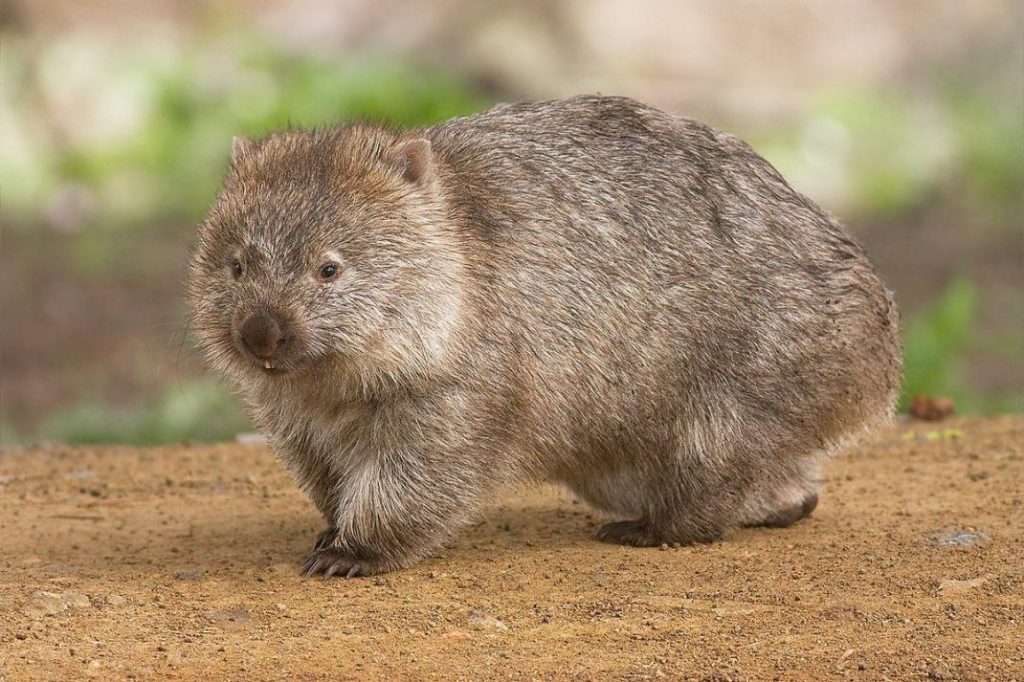Fact file about the Wombat

Wombats are pudgy marsupials found on mainland Australia and the scattered islands of Australia.Their size is like the size of a medium-sized dog, i.e., 30 inches long. They weigh 24-40kg while the hairy-nosed wombat weighs 19-32kg. They have a lifespan of around 5-15 years in the wild and 20 in the Zoos. The Wombats are nocturnal and eat at night. Their rodent-like incisors grow and help them eat tough vegetation. Wombats have special enzymes that help their stomach digest food. They take 14 days to digest their food.Diet, Habitat, and Behaviour:Diet: Wombats are herbivores. The common food for wombats include roots, grasses, scrub, herbs and bark. Most of their water requirements come from foods they eat. Wombats can live for years without drinking water.Habitat: Wombats live in Australian mountains, forests and grasslands. They live in burrows, which include many tunnels that can reach up to 650ft in length. Some wombats live in many burrows throughout its lifetime.Behaviour: Wombats mark their territory by using their cubed-like poop. They place their poop on fallen trees, fresh mushrooms and rocks.Wombats mate during a time when there is an abundance of food. They will not mate during a drought or during a time when there is a lack of food. The two male Wombats compete for the right to mate. Wombats can be social or loners. They swim but do not climb trees like their closest relative, the Koala. During Winter, they come out of their burrows to sunbathe and warm up.A Wombat’s gestation period is between 21 -30 days. Wombats only give birth to 1-2 young (also known as a Joey), every two years. The Joey weighs 2g at birth and they are small as a jellybean. The Joey stays in the mother’s pouch for five months until they develop. After 5 months, they will come in and out of their mothers pouch for a few months until they grow. Wombats mature at 1.5-3 years.Threats and Conservation efforts:Threats: Conflict with humans, damage to their habitat including damage to the field and pasture from which they eat their food are just some problems facing the Wombat’s existence. Also, hunters hunt the Wombats for their fur and as a sport, which is causing a decrease in their population. Unchecked grazing by cattle and other domestic animals leads to a decline in food for the Wombats. This leads to starvation and death. Disease and wildfires do not help the Wombats survival.Conservation Efforts: The efforts made to save the Wombats from extinction are the initiation of legislations like the Queensland Nature Conservation Act 1992; Commonwealth Environment Protection and Biodiversity Conservation Act 1999. The Conservation Services Division has come up with recovery plans to help the Northern Hairy-Nosed Wombat survive. There are also organisations like The Wombat Foundation, The Wildlife Preservation Society of Australia, and The Australian Wombat Rehabilitation Centre. These organisations aim at conserving the Wombat populations in the wild. Zoos and National Parks also help in conserving Wombat populations. Sources: https://www.nationalgeographic.com/animals/mammals/c/common-wombat/https://www.environment.gov.au/biodiversity/threatened/recovery-plans/recovery-plan-northern-hairy-nosed-wombat-lasiorhinus-krefftii-2004-2008https://www.livescience.com/52640-wombats.htmlhttps://chloelikeswombats.weebly.com/conservation.html

